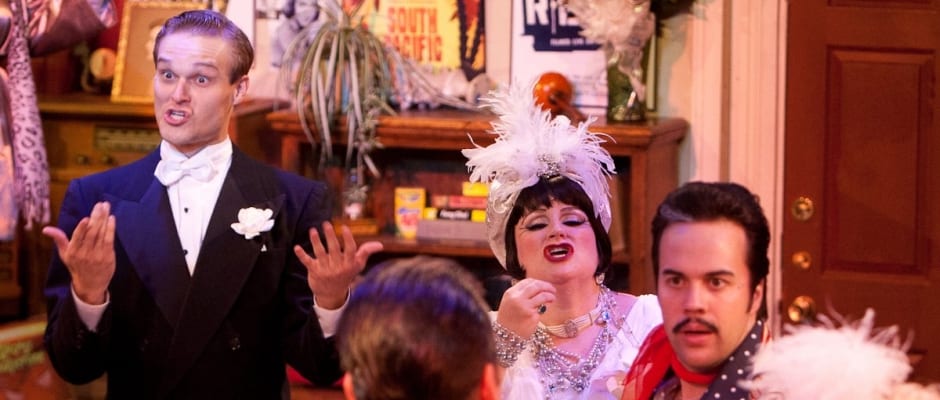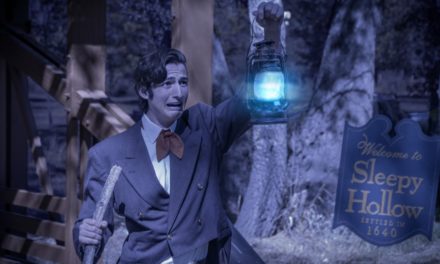
Playing thru October 1, 2011
OREM — Everybody loves to share their favorite music with their family and friends. It may be while on a long drive, during a holiday weekend, or just as part of an informal get-together. Whatever the situation, it’s always a lot of fun to share a song, a band, or an album with a friend and be with them when they experience the music for the first time. For people who love musicals, though, the experience of sharing a cast album also includes sharing information about the show: its plot, characters, actors, or details about the original production or a production that made them fall in love with the show. The Drowsy Chaperone is based around the premise of the central character—called nothing more than Man in Chair—sharing the cast album of the musical of the same name with the audience. Having gushed about shows with friends and family while they listen to the album with me, it’s a premise that I can buy into wholeheartedly.
The musical with the show is the fictional 1920’s musical The Drowsy Chaperone. As the album progresses, the Man in Chair (played by Brett Merritt) explains the story, the characters, and the world of the 1920’s in a way that inevitably drew me into the show. It is no exaggeration to say that the success of a production of The Drowsy Chaperone rests on the portrayal of the Man in Chair. Throughout opening night, Merritt effectively played a Man in Chair who is riddled with social anxieties and a complicated past, yet can still find joy in his favorite cast album.
I was impressed that Dave Tinney’s direction was nuanced when the emotion of the script dictate it, but also embraced the cheesiness of the frivolous musicals of the period. I especially enjoyed his direction of “An Accident Waiting to Happen,” which swept me up in the gimmick of the song and charmed me into accepting the scene for what it is—a homage to the 1920’s. Also, Tinney correctly directed his actors to play characters like Underling and Kitty as types instead of fully developed human beings. I think it would have been a gross error if the actors had tried to give serious existence to such characters and Tinney was smart to keep these characters superficial.
Almost all the other characters in the play reside within the fictional musical. My favorite performances of the evening were from David Smith—who played Robert Martin—and Darick J. Pead—who played Adolpho. Both actors seemed fully committed to the silliness that their roles demanded. Smith‘s performance on rollerskates was charming and Pead‘s willingness to constantly push the boundaries of absurdity was pleasing to me.
Technically, Bobby Swenson’s set is the most impressive visual aspect of this production. Even before the Man in Chair appeared on stage, I could correctly guess two things about the person who lived in the apartment: that he loved musical theatre and that he was incredibly lonely. (The stacks of ramen noodles and macaroni and cheese tipped me off about the latter.) I’m always impressed when set designers can effectively convey information about characters. I also enjoyed Cody Swenson‘s lighting design as it effectively moved between the “real world” of the Man in Chair and the fantasy world of the musical. However, some of the lighting cues seemed to have been executed at the wrong times (such as the camera flashes during “Show Off”) and there were many instances where characters were singing a beat or two in the dark.
The script (written by Bob Martin and Don McKellar) is incredibly witty and full of many comedic moments that the actors capitalized on. I also adore the careful balancing act of the script. It effectively is a love letter to the shallow musicals of the pre-Oklahoma! era, while effectively winking and saying, “Weren’t these shows just ridiculous? Can you believe that people liked them?” As far as the music goes, Lisa Lambert and Greg Morrison‘s score borrows heavily from the sounds of the Jazz Age, and it is a joy to listen to. The score was bolstered by the actors’ strong vocal talents. I especially enjoyed listening to Mackenzie Seiler‘s velvety voice as she sang “I Do, I Do in the Sky” and Nicole Riding’s bombastic rendition of “Show Off.”
There are some minor problems with this production of The Drowsy Chaperone, but not many. The Hale’s tiny stage often constrained the choreography to be more subdued and less energetic than I would imagine it would be on a large proscenium stage, especially for the opening number, “Cold Feet,” and “Toledo Surprise.” Also, when the rest of the set is so impressive, the swing for “An Accident Waiting to Happen” is a little pathetic, being made of anachronistic plastic and modern rope. But I hope that these points don’t detract from what is really a delightful evening from start to finish.
So, yes, I recommend The Drowsy Chaperone. I hope Utah audiences will fall in love with this show as its main character shares its music with them. Perhaps they, in turn, will become the Man in Chair as they share the music of The Drowsy Chaperone with others in the future.

Photo courtesy of Pete Widtfeldt © 2011 – CanIGetACopy.com





